EVPN-VXLAN VPWS
This chapter provides information about EVPN-VXLAN VPWS.
Topics in this chapter include:
Applicability
This chapter was initially written for SR OS Release 16.0.R7, but the CLI in the current edition is based on SR OS Release 21.5.R2.
Overview
Some service providers use VXLAN as a next-generation access technology between Multi-Service Access Node (MSAN) PE and core PE routers. VXLAN allows any IP router in the aggregation core and provides a simple alternative to MPLS. Static VXLAN bindings can be used when the MSAN PEs do not support any control plane. However, EVPN offers a control plane protocol for the VXLAN bindings for faster convergence and fault propagation. In this chapter, the focus is on EVPN-VPWS, which provides a lighter control plane compared to full-blown EVPN when point-to-point services need to be extended to the Data Center (DC).
EVPN-VXLAN VPWS is similar to EVPN-MPLS VPWS, including support of Equal Cost Multi-Path (ECMP), and EVPN All-Active (AA) and Single-Active (SA) Multi-Homing (MH). The configuration resembles the EVPN-MPLS Epipe configuration, as described in the EVPN for MPLS Tunnels in Epipe Services (EVPN-VPWS) chapter. As an example, the following configures EVPN-VXLAN Epipe 4 with SA MH.
# on PE-4:
configure
service
sdp 460 create
description "GRE SDP for SA MH"
far-end 192.0.2.6
keep-alive
shutdown
exit
no shutdown
exit
system
bgp-evpn
ethernet-segment "ES45" create
esi 01:00:00:00:00:45:00:00:00:04
es-activation-timer 3
service-carving
mode auto
exit
multi-homing single-active
sdp 460
no shutdown
exit
exit
exit
epipe 4 name "Epipe-4" customer 1 create
vxlan instance 1 vni 4 create
exit
bgp
exit
bgp-evpn
local-attachment-circuit AC-45 create
eth-tag 145
exit
remote-attachment-circuit AC-23 create
eth-tag 123
exit
evi 4
vxlan bgp 1 vxlan-instance 1
ecmp 2
send-tunnel-encap # default
no shutdown
exit
exit
spoke-sdp 460:4 create
no shutdown
exit
no shutdown
exit
The SDP is a GRE SDP, because no MPLS is configured in the network. The VNI is 4, and the local Attachment Circuit (AC) name is "AC-45" with Ethernet tag 145, whereas the remote AC name is "AC-23" with Ethernet tag 123. An ES can contain up to four nodes. Each of these nodes will have the same local Ethernet tag.
On Epipe services, the BGP instance is 1 and the VXLAN instance is 1. ECMP is configured with a value of 2, so the traffic flows can be sprayed over two paths with equal cost (a value greater than 2 can be configured if aliasing to more than two nodes is needed). By default, send-tunnel-encap is enabled, which determines whether the RFC 5512 encapsulation extended community is sent with VXLAN value (if enabled) or not sent.
EVPN-VPWS uses BGP-EVPN route type 1 (autodiscovery (AD) per-EVI routes and AD per-ES routes) and route type 4 (Ethernet Segment (ES) routes); it does not use route types 2 (MAC/IP routes), 3 (Inclusive Multicast routes), or 5 (IP Prefix routes). BGP-EVPN AD per-EVI route shows the fields in a BGP-EVPN AD per-EVI route.
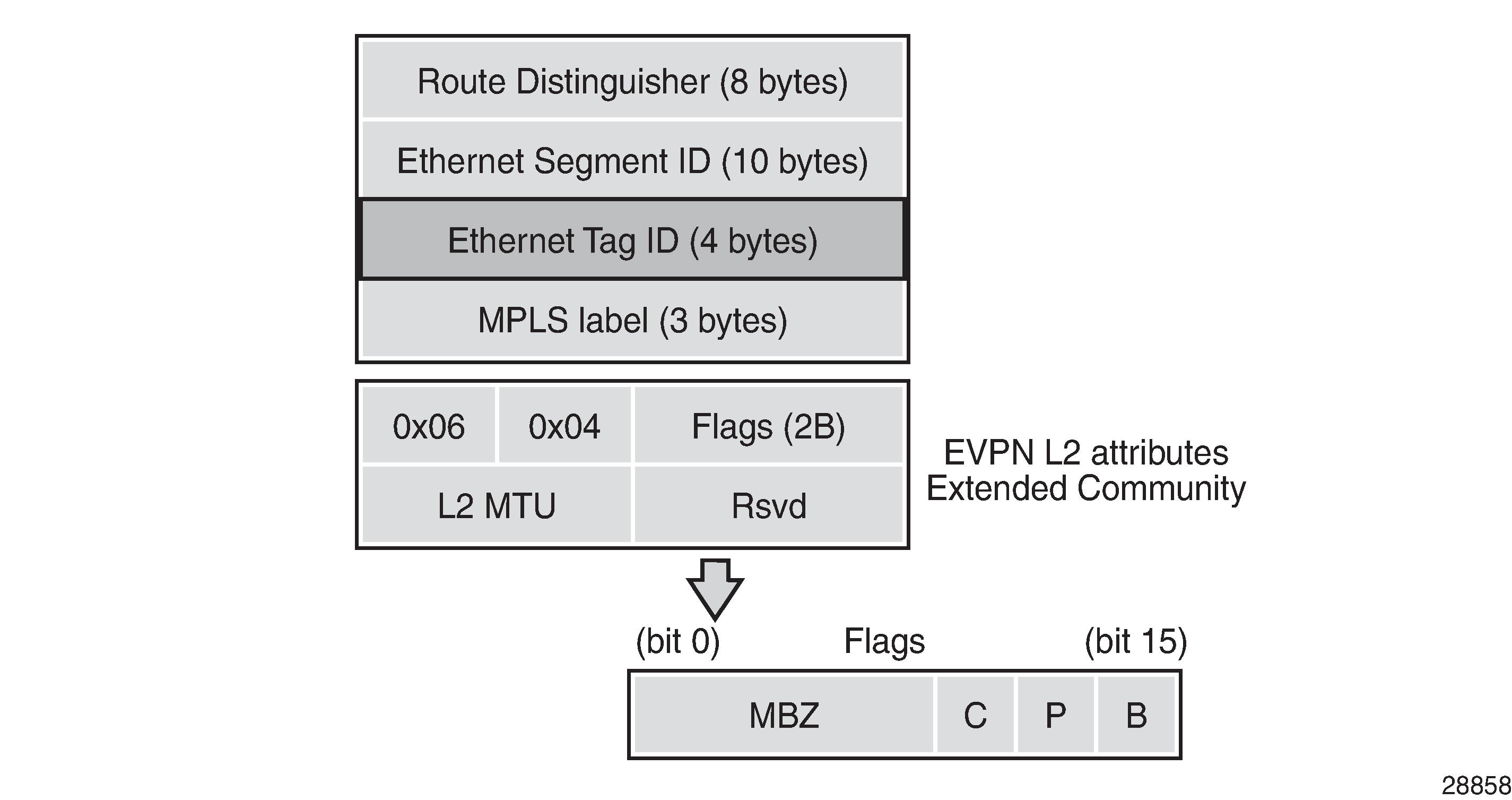
The Route Distinguisher (RD) is encoded as specified in RFC 7432; in this example, the system IP address is followed by the service ID, such as 192.0.2.2:1 for Epipe 1 on PE-2. The MPLS label field is encoded as the VXLAN Network Identifier (VNI) and the Ethernet tag field defines the local Attachment Circuit (AC) ID. The ES ID (ESI) is the 10 bytes configured ESI for MH and equals zero for single-homed services.
The EVPN L2 attributes extended community has type 0x06 (EVPN) and subtype 0x04 (EVPN L2 attributes). The flags are defined as follows:
Flag C (control word) is set if control word is configured in the service. For EVPN-MPLS VPWS, the control word can be configured in the bgp-evpn>mpls context, but for EVPN-VXLAN VPWS, the control word cannot be configured in the bgp-evpn>vxlan context, so flag C is always zero (C=0).
Flag P (primary) is set in MH scenarios: all nodes in an AA MH ES send P=1, but in an SA MH ES, only the Designated Forwarder (DF) sends P=1, while the NDFs send P=0. In single-homed scenarios, all nodes send P=0.
Flag B (backup) is set in SA MH scenarios: the NDF that will take the primary role after the original primary node has failed is the backup, so it sends B=1. All other NDFs have B=0. In AA MH scenarios, all nodes send B=0. Also, in single-homed scenarios, all nodes except for the backup DF send B=0.
If the received L2 MTU does not match the configured service MTU, the EVPN binding is not set up. However, if the received L2 MTU is zero, the MTU is ignored.
AD per-EVI routes are responsible for aliasing. The following BGP update shows an AD per-EVI route received from DF 192.0.2.4 (PE-4) in an SA MH ES with ESI 01:00:00:00:00:45:00:00:00:04, Ethernet tag 145 for the local AC on PE-4, and MPLS label 4 for Epipe 4. The primary flag is set: P=1.
50 2021/06/29 12:03:54.278 UTC MINOR: DEBUG #2001 Base Peer 1: 192.0.2.4
"Peer 1: 192.0.2.4: UPDATE
Peer 1: 192.0.2.4 - Received BGP UPDATE:
Withdrawn Length = 0
Total Path Attr Length = 81
Flag: 0x90 Type: 14 Len: 36 Multiprotocol Reachable NLRI:
Address Family EVPN
NextHop len 4 NextHop 192.0.2.4
Type: EVPN-AD Len: 25 RD: 192.0.2.4:4 ESI: 01:00:00:00:00:45:00:00:00:04,
tag: 145 Label: 4
Flag: 0x40 Type: 1 Len: 1 Origin: 0
Flag: 0x40 Type: 2 Len: 0 AS Path:
Flag: 0x40 Type: 5 Len: 4 Local Preference: 100
Flag: 0xc0 Type: 16 Len: 24 Extended Community:
target:64500:4
l2-attribute:MTU: 1514 C: 0 P: 1 B: 0
bgp-tunnel-encap:VXLAN
"
As per RFC 8214, in an AD per-ES route, the Ethernet tag is MAX-ET (all bits are set), the MPLS label is zero, and the BGP extended community contains the single-active flag (1 for SA and 0 for AA) and ESI label. BGP-EVPN AD per-ES route shows the fields in a BGP-EVPN AD per-ES route.
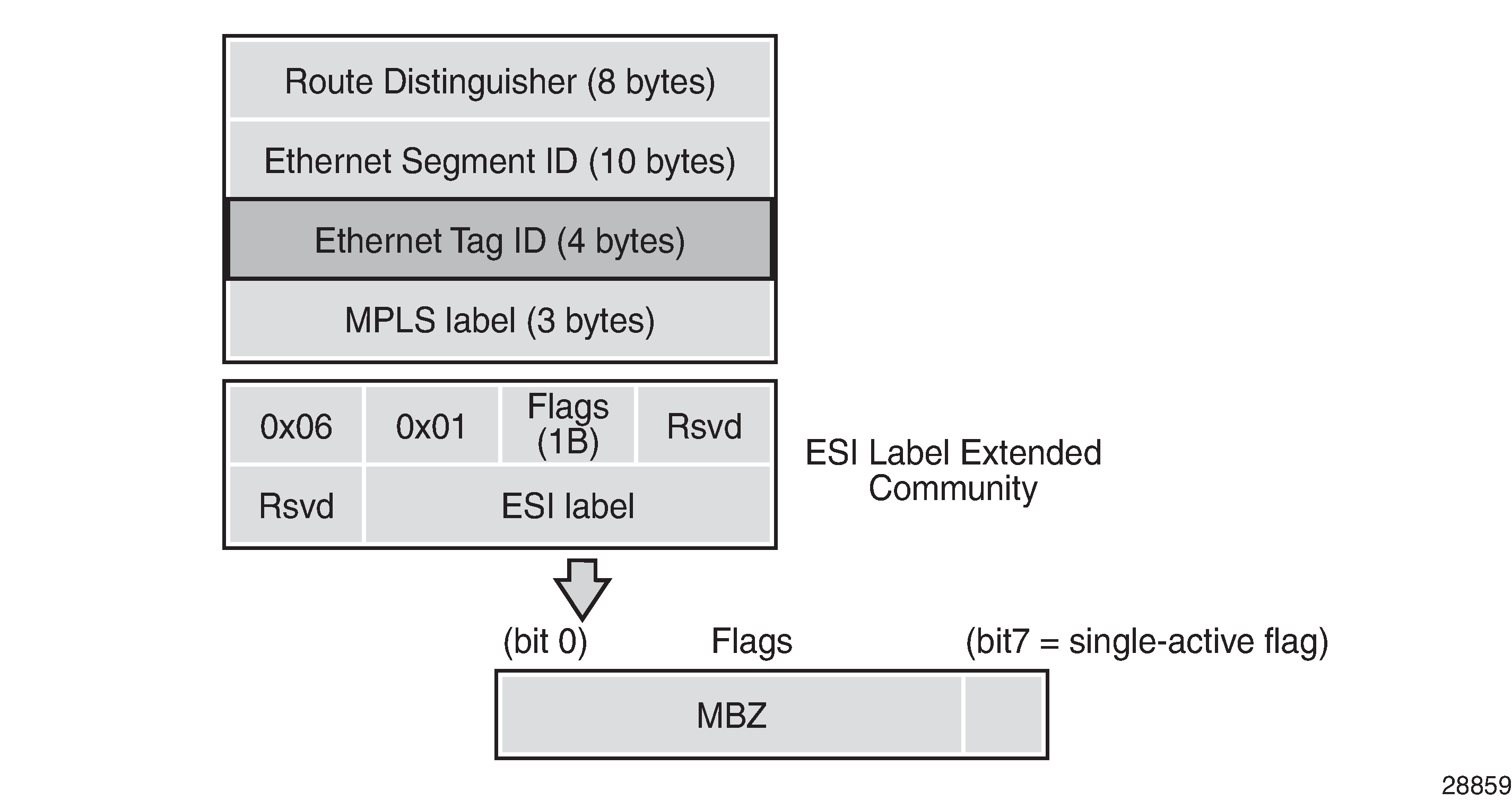
The following AD per-ES route is received by PE-2 from PE-4, which is in an SA MH ES with ESI 01:00:00:00:00:45:00:00:00:04.
52 2021/06/29 12:03:18.185 UTC MINOR: DEBUG #2001 Base Peer 1: 192.0.2.4
"Peer 1: 192.0.2.4: UPDATE
Peer 1: 192.0.2.4 - Received BGP UPDATE:
Withdrawn Length = 0
Total Path Attr Length = 73
Flag: 0x90 Type: 14 Len: 36 Multiprotocol Reachable NLRI:
Address Family EVPN
NextHop len 4 NextHop 192.0.2.4
Type: EVPN-AD Len: 25 RD: 192.0.2.4:4 ESI: 01:00:00:00:00:45:00:00:00:04,
tag: MAX-ET Label: 0
Flag: 0x40 Type: 1 Len: 1 Origin: 0
Flag: 0x40 Type: 2 Len: 0 AS Path:
Flag: 0x40 Type: 5 Len: 4 Local Preference: 100
Flag: 0xc0 Type: 16 Len: 16 Extended Community:
target:64500:4
esi-label:524284/Single-Active
"
BGP-EVPN ES route shows a BGP-EVPN route type 4 (ES route) that is used for MH ES discovery and DF election.
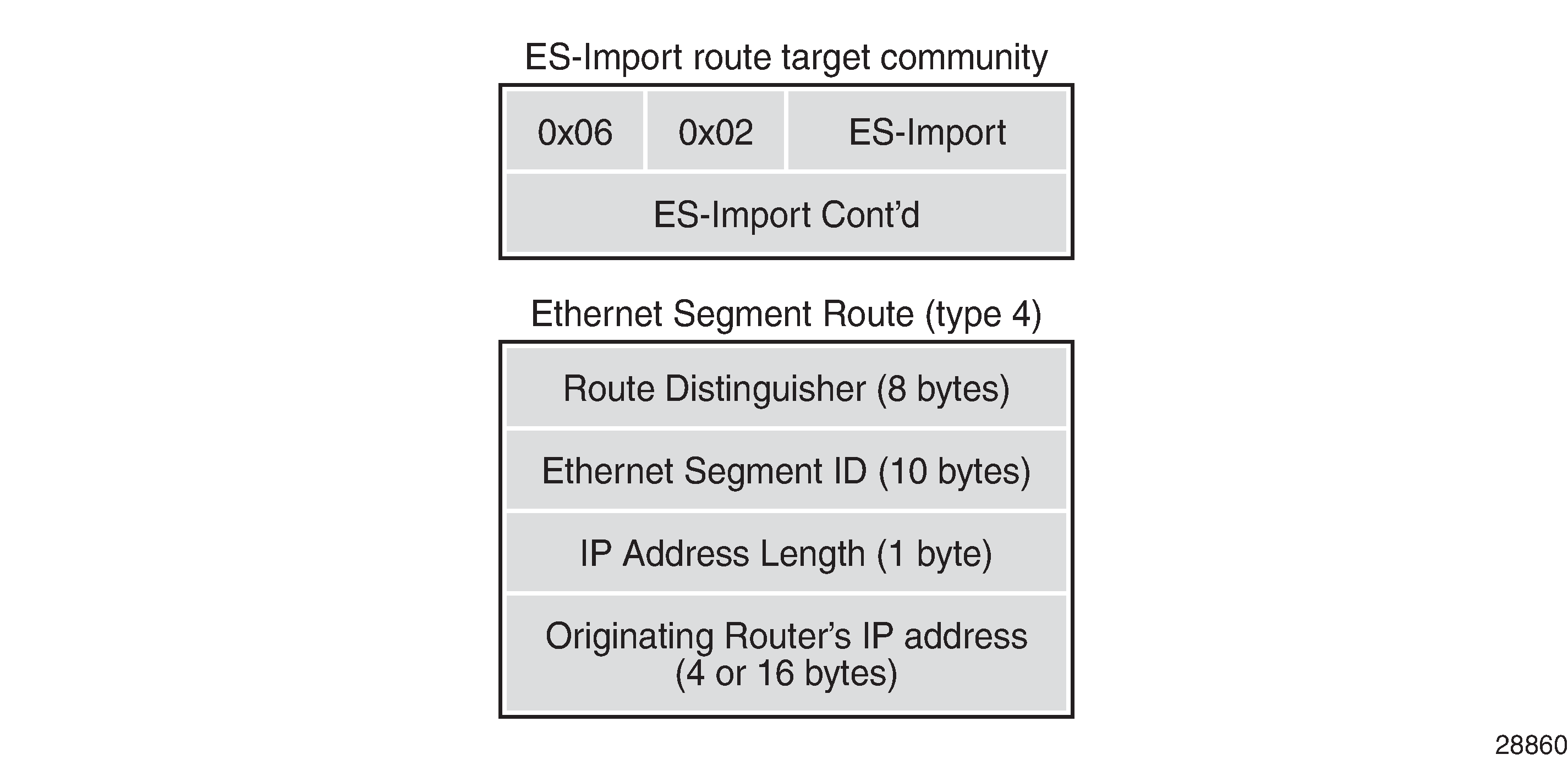
The RD is taken from the system level RD; by default, the RD is derived as system-IP:0, such as 192.0.2.4:0 for PE-4. The ESI contains the 10-byte identifier as configured in the ES. The ES import route target community has type 0x06 (EVPN) and subtype 0x02 (ES import route target), and is derived from the MAC address portion of the ESI. This extended community is treated as a route target, such as: target:00:00:00:00:45:00. Only the PEs attached to the ES will import the ES route.
The following BGP update shows a BGP-EVPN ES route sent by PE-4. The RD is defined as 192.0.2.4:0, the ESI is 01:00:00:00:00:45:00:00:00:04, and the originating IP address is 192.0.2.4 for PE-4. The ES import route target is target:00:00:00:00:45:00.
45 2021/06/29 12:07:09.822 UTC MINOR: DEBUG #2001 Base Peer 1: 192.0.2.2
"Peer 1: 192.0.2.2: UPDATE
Peer 1: 192.0.2.2 - Send BGP UPDATE:
Withdrawn Length = 0
Total Path Attr Length = 71
Flag: 0x90 Type: 14 Len: 34 Multiprotocol Reachable NLRI:
Address Family EVPN
NextHop len 4 NextHop 192.0.2.4
Type: EVPN-ETH-SEG Len: 23 RD: 192.0.2.4:0 ESI: 01:00:00:00:00:45:00:00:00:04,
IP-Len: 4 Orig-IP-Addr: 192.0.2.4
Flag: 0x40 Type: 1 Len: 1 Origin: 0
Flag: 0x40 Type: 2 Len: 0 AS Path:
Flag: 0x40 Type: 5 Len: 4 Local Preference: 100
Flag: 0xc0 Type: 16 Len: 16 Extended Community:
df-election::DF-Type:Auto/DP:0/DF-Preference:0/AC:1
target:00:00:00:00:45:00
"
By default, the system IP addresses are used for the VXLAN tunnel termination. However, it is possible to use non-system IPv4 or IPv6 termination for EVPN-VXLAN VPWS, both for single-homed and multi-homed services. In that case, Forwarding Path Extension (FPE) needs to be defined with VXLAN termination, as described in chapter Static VXLAN Termination in Epipe Services.
The following shows the configuration of the single-homed Epipe 2 using non-system IPv4 source VXLAN Tunnel Endpoint (VTEP) 10.0.3.1 on PE-3. Likewise, it is possible to use a non-system IPv6 source VTEP, such as vxlan-src-vtep 2001::3:1. Unlike the source VTEP, the egress VTEP cannot be configured when BGP-EVPN is enabled. The egress VTEP is dynamically learned via BGP instead.
# on PE-3:
configure
service
epipe 2 name "Epipe-2" customer 1 create
vxlan-src-vtep 10.0.3.1
vxlan instance 1 vni 2 create
exit
bgp
exit
bgp-evpn
local-attachment-circuit AC-3 create
eth-tag 103
exit
remote-attachment-circuit AC-5 create
eth-tag 105
exit
evi 2
vxlan bgp 1 vxlan-instance 1
send-tunnel-encap # default
no shutdown
exit
exit
sap 1/1/1:2 create
no shutdown
exit
no shutdown
Configuration
The following use cases are included in the configuration section:
Single-homed EVPN-VXLAN Epipe using IPv4 system addresses
Single-homed EVPN-VXLAN Epipe using non-system IPv4 addresses
Single-homed EVPN-VXLAN Epipe using non-system IPv6 addresses
AA and SA multi-homed EVPN-VXLAN Epipe using IPv4 system addresses
AA and SA multi-homed EVPN-VXLAN Epipe using non-system IPv4 addresses
AA and SA multi-homed EVPN-VXLAN Epipe using non-system IPv6 addresses
Example topology shows the example topology with six PEs. EVPN-VXLAN Epipe services will be configured on the core PEs PE-2, PE-3, PE-4, and PE-5. On the access nodes PE-1 and PE-6, ordinary Epipe services will be configured, without EVPN-VXLAN. The CEs are emulated by VPRN services configured on PE-1 or PE-6.
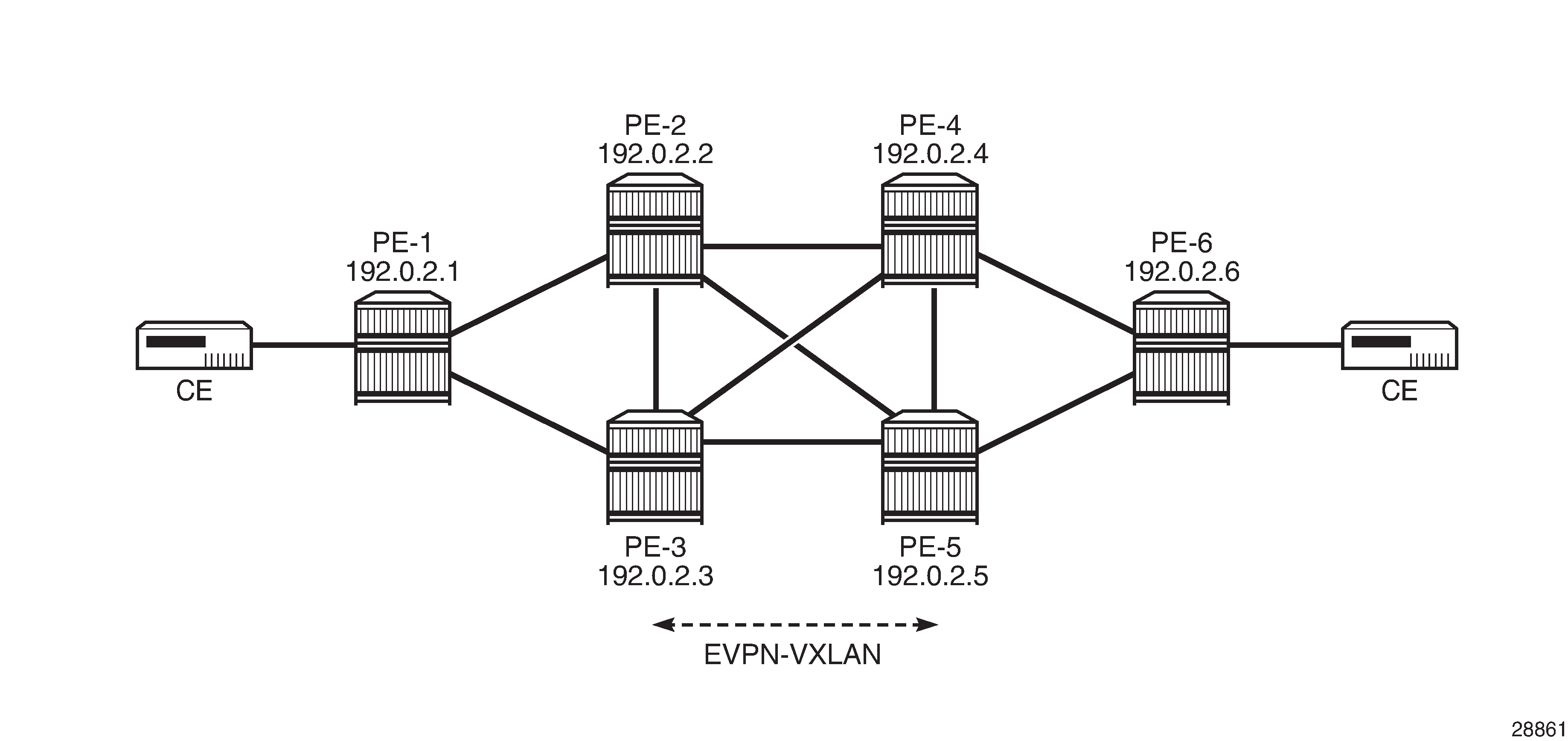
The initial configuration includes:
Cards, MDAs, ports
Router interfaces
IS-IS on all router interfaces: level 2 between the core PEs and level 1 in the access networks
No MPLS protocol is configured.
BGP is configured on the core PEs for the EVPN address family with RR PE-2. The BGP configuration on RR PE-2 is as follows:
# on PE-2:
configure
router Base
autonomous-system 64500
bgp
vpn-apply-import
vpn-apply-export
rapid-update evpn
group "iBGP"
family evpn
type internal
cluster 192.0.2.2
split-horizon
neighbor 192.0.2.3
exit
neighbor 192.0.2.4
exit
neighbor 192.0.2.5
exit
exit
no shutdown
Single-homed EVPN-VXLAN Epipe using system IPv4 addresses
Single-homed EVPN-VXLAN Epipe 1 using system IP addresses shows the routers PE-1, PE-2, PE-4, and PE-6 configured with Epipe 1. VXLAN-EVPN is only configured on the core PEs PE-2 and PE-4.

Configuration of Epipe 1
On PE-1, Epipe 1 is configured without EVPN-VXLAN, as follows.
# on PE-1:
configure
service
epipe 1 name "Epipe-1" customer 1 create
sap 1/1/1:1 create
no shutdown
exit
sap 1/2/1:1 create
no shutdown
exit
no shutdown
exit
On PE-2, Epipe 1 is configured with EVPN-VXLAN. The local AC "AC-2" has Ethernet tag 102 and the remote AC is "AC-4" with Ethernet tag 104, as follows:
# on PE-2:
configure
service
epipe 1 name "Epipe-1" customer 1 create
vxlan instance 1 vni 1 create
exit
bgp
exit
bgp-evpn
local-attachment-circuit AC-2 create
eth-tag 102
exit
remote-attachment-circuit AC-4 create
eth-tag 104
exit
evi 1
vxlan bgp 1 vxlan-instance 1
no shutdown
exit
exit
sap 1/1/2:1 create
no shutdown
exit
no shutdown
exit
The Epipe configuration on PE-4 is similar, but the local AC and remote AC are swapped, as follows. Instead of a SAP, a spoke-SDP is configured toward PE-6. The SDP itself is GRE-based.
# on PE-4:
configure
service
sdp 46 create
description "GRE SDP for single-homing"
far-end 192.0.2.6
keep-alive
shutdown
exit
no shutdown
exit
epipe 1 name "Epipe-1" customer 1 create
vxlan instance 1 vni 1 create
exit
bgp
exit
bgp-evpn
local-attachment-circuit AC-4 create
eth-tag 104
exit
remote-attachment-circuit AC-2 create
eth-tag 102
exit
evi 1
vxlan bgp 1 vxlan-instance 1
send-tunnel-encap # default
no shutdown
exit
exit
spoke-sdp 46:1 create
no shutdown
exit
no shutdown
exit
On PE-6, Epipe 1 is an ordinary Epipe with spoke-SDP 64:1 toward PE-4 and SAP 1/2/1:1 toward a CE, as follows:
# on PE-6:
configure
service
sdp 64 create
description "GRE SDP for single-homing"
far-end 192.0.2.4
keep-alive
shutdown
exit
no shutdown
exit
epipe 1 name "Epipe-1" customer 1 create
sap 1/2/1:1 create
no shutdown
exit
spoke-sdp 64:1 create
no shutdown
exit
no shutdown
exit
Verification
VPRN 11 on PE-1 and PE-6 simulates the CEs CE-11 and CE-61. The connectivity between the CEs can be verified as follows:
*A:PE-1# ping router 11 172.16.11.61 rapid
PING 172.16.11.61 56 data bytes
!!!!!
---- 172.16.11.61 PING Statistics ----
5 packets transmitted, 5 packets received, 0.00% packet loss
round-trip min = 4.26ms, avg = 4.40ms, max = 4.54ms, stddev = 0.099ms
*A:PE-1# ping router 11 2001:db8::11:61 rapid
PING 2001:db8::11:61 56 data bytes
!!!!!
---- 2001:db8::11:61 PING Statistics ----
5 packets transmitted, 5 packets received, 0.00% packet loss
round-trip min = 3.80ms, avg = 3.96ms, max = 4.22ms, stddev = 0.153ms
On PE-2, the VXLAN destination for Epipe 1 is the system address of PE-4: 192.0.2.4, as follows. There are no VXLAN ES destinations for Epipe 1, because the service is single-homed.
*A:PE-2# show service id 1 vxlan destinations
===============================================================================
Egress VTEP, VNI
===============================================================================
VTEP Address Egress VNI Oper Vxlan
State Type
-------------------------------------------------------------------------------
192.0.2.4 1 Up evpn
-------------------------------------------------------------------------------
Number of Egress VTEP, VNI : 1
-------------------------------------------------------------------------------
===============================================================================
===============================================================================
BGP EVPN VXLAN ES Dest
===============================================================================
I Eth Seg Id TEP Address VNI Last Changed
-------------------------------------------------------------------------------
No Matching Entries
===============================================================================
The following BGP-EVPN information for Epipe 1 on PE-2 includes the EVI and the AC names and Ethernet tags. For Epipes, the BGP instance ID and VXLAN instance ID always equal 1.
*A:PE-2# show service id 1 bgp-evpn
===============================================================================
BGP EVPN Table
===============================================================================
EVI : 1 Creation Origin : manual
Local AC Name : AC-2
Eth Tag : 102
Endpoint : (Not Specified)
Ingress Label : 0
Remote AC Name : AC-4
Eth Tag : 104
Endpoint : (Not Specified)
===============================================================================
BGP EVPN VXLAN Information
===============================================================================
Admin Status : Enabled Bgp Instance : 1
Vxlan Instance : 1
Max Ecmp Routes : 1
Default Route Tag : none
Send EVPN Encap : Enabled
===============================================================================
PE-2 has received the following BGP-EVPN AD per-EVI route with RD 192.0.2.4:1 and Ethernet tag 104 from PE-4. Epipe 1 is single-homed, so ESI=0 and there is no primary or backup node (P=B=0). Also, no control word is used, so C=0.
5 2021/06/29 09:12:57.131 UTC MINOR: DEBUG #2001 Base Peer 1: 192.0.2.4
"Peer 1: 192.0.2.4: UPDATE
Peer 1: 192.0.2.4 - Received BGP UPDATE:
Withdrawn Length = 0
Total Path Attr Length = 81
Flag: 0x90 Type: 14 Len: 36 Multiprotocol Reachable NLRI:
Address Family EVPN
NextHop len 4 NextHop 192.0.2.4
Type: EVPN-AD Len: 25 RD: 192.0.2.4:1 ESI: ESI-0, tag: 104 Label: 1
Flag: 0x40 Type: 1 Len: 1 Origin: 0
Flag: 0x40 Type: 2 Len: 0 AS Path:
Flag: 0x40 Type: 5 Len: 4 Local Preference: 100
Flag: 0xc0 Type: 16 Len: 24 Extended Community:
target:64500:1
l2-attribute:MTU: 1514 C: 0 P: 0 B: 0
bgp-tunnel-encap:VXLAN
"
The following shows the received BGP-EVPN AD per-EVI routes with RD 192.0.2.4:1 on PE-2.
*A:PE-2# show router bgp routes evpn auto-disc rd 192.0.2.4:1
===============================================================================
BGP Router ID:192.0.2.2 AS:64500 Local AS:64500
===============================================================================
Legend -
Status codes : u - used, s - suppressed, h - history, d - decayed, * - valid
l - leaked, x - stale, > - best, b - backup, p - purge
Origin codes : i - IGP, e - EGP, ? - incomplete
===============================================================================
BGP EVPN Auto-Disc Routes
===============================================================================
Flag Route Dist. ESI NextHop
Tag Label
-------------------------------------------------------------------------------
u*>i 192.0.2.4:1 ESI-0 192.0.2.4
104 VNI 1
-------------------------------------------------------------------------------
Routes : 1
===============================================================================
Single-homed EVPN-VXLAN Epipe using non-system IPv4 addresses
Single-homed EVPN-VXLAN Epipe 2 using non-system IP addresses shows the single-homed service Epipe 2 configured on PE-1, PE-3, PE-5, and PE-6. On PE-3, a loopback interface is created in the base router with IPv4 address 10.0.3.3/28. Epipe 2 uses VXLAN termination 10.0.3.1 from the same subnet.
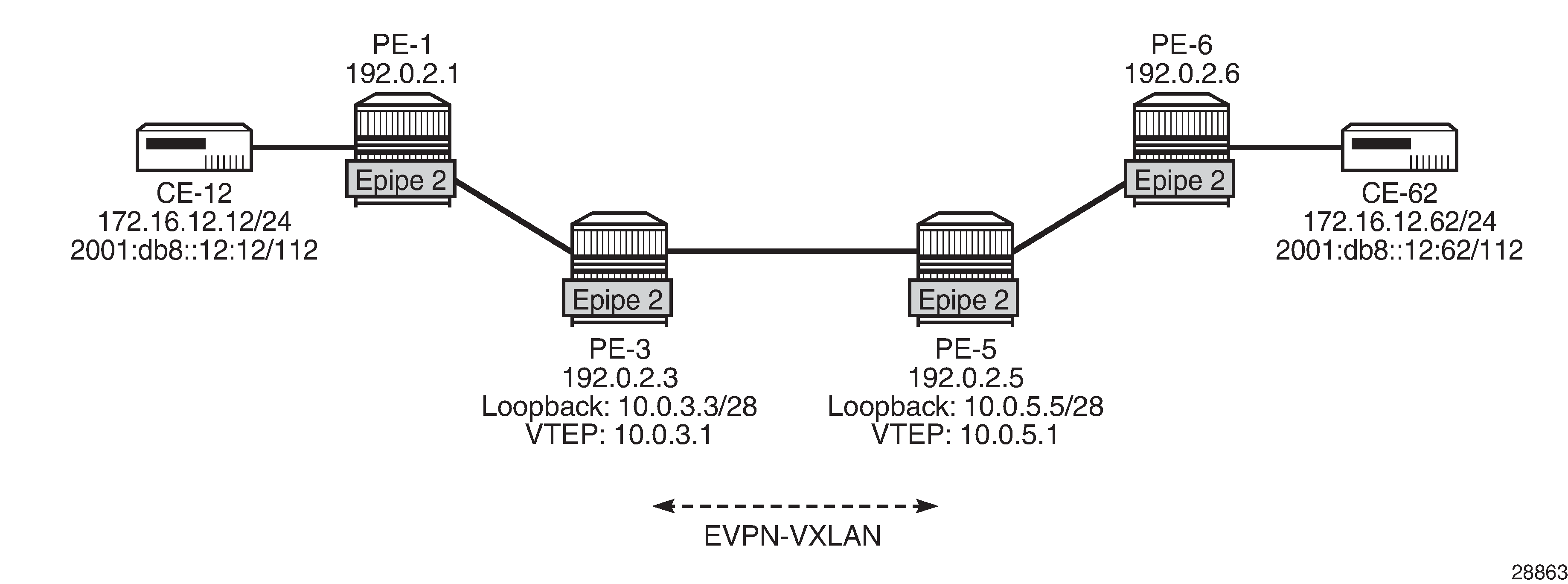
Configuration of Epipe 2
On PE-1 and PE-6, the configuration of Epipe 2 is similar to the configuration of Epipe 1.
On PE-3, FPE needs to be configured using PXC, as described in chapter Static VXLAN Termination in Epipe Services. The following configuration is included without further explanation about FPE or PXC. The same configuration is required on PE-5.
# on PE-3:
configure
port-xc
pxc 1 create
port 1/2/5
no shutdown
exit
exit
port 1/2/5
ethernet
dot1x
tunneling
exit
mode hybrid
encap-type dot1q
exit
no shutdown
exit
port pxc-1.a
ethernet
exit
no shutdown
exit
port pxc-1.b
ethernet
exit
no shutdown
exit
fwd-path-ext
sdp-id-range from 10000 to 10127
fpe 1 create
path pxc 1
vxlan-termination
exit
On PE-3, the following loopback interface is created and IS-IS is enabled on it. The subnet must allow multiple IP addresses; one other IP address from the subnet will be defined as VXLAN tunnel termination. The IPv6 address is only required in the next use-case, but this configuration will not be repeated in that section.
# on PE-3:
configure
router Base
interface "lo1"
address 10.0.3.3/28
loopback
ipv6
address 2001::3:3/124
exit
exit
isis 0
interface "lo1"
passive
exit
exit
Up to three VXLAN tunnel terminations can be defined per system. On PE-3, the following two VXLAN tunnel terminations are configured. For Epipe 2, only the first VXLAN tunnel termination is required; the second (IPv6) VXLAN tunnel termination is used in Epipe 3. The VXLAN tunnel termination is used as VXLAN source VTEP in Epipe 2. No egress VTEP can be defined when BGP-EVPN is configured in the service; egress VTEPs are configured in static VXLAN tunnels instead.
# on PE-3:
configure
service
system
vxlan
tunnel-termination 10.0.3.1 fpe 1 create
tunnel-termination 2001::3:1 fpe 1 create
exit
exit
epipe 2 name "Epipe-2" customer 1 create
vxlan-src-vtep 10.0.3.1
vxlan instance 1 vni 2 create
exit
bgp
exit
bgp-evpn
local-attachment-circuit AC-3 create
eth-tag 103
exit
remote-attachment-circuit AC-5 create
eth-tag 105
exit
evi 2
vxlan bgp 1 vxlan-instance 1
send-tunnel-encap # default
ecmp 2
no shutdown
exit
exit
sap 1/1/1:2 create
no shutdown
exit
no shutdown
exit
The configuration on PE-5 is similar. The following is the service configuration on PE-5.
# on PE-5:
configure
service
sdp 56 create
description "GRE SDP for single-homing"
far-end 192.0.2.6
keep-alive
shutdown
exit
no shutdown
exit
system
vxlan
tunnel-termination 10.0.5.1 fpe 1 create
tunnel-termination 2001::5:1 fpe 1 create
exit
exit
epipe 2 name "Epipe-2" customer 1 create
vxlan-src-vtep 10.0.5.1
vxlan instance 1 vni 2 create
exit
bgp
exit
bgp-evpn
local-attachment-circuit AC-5 create
eth-tag 105
exit
remote-attachment-circuit AC-3 create
eth-tag 103
exit
evi 2
vxlan bgp 1 vxlan-instance 1
send-tunnel-encap # default
ecmp 2
no shutdown
exit
exit
spoke-sdp 56:2 create
no shutdown
exit
no shutdown
exit
It is possible to use a system IPv4 address as a VXLAN tunnel termination on one of the nodes and a non-system IPv4 address on another, but that is not configured here.
Verification
The connectivity between the CEs that are emulated by VPRN 12 can be verified as follows:
*A:PE-1# ping router 12 172.16.12.62 rapid
PING 172.16.12.62 56 data bytes
!!!!!
---- 172.16.12.62 PING Statistics ----
5 packets transmitted, 5 packets received, 0.00% packet loss
round-trip min = 4.27ms, avg = 4.77ms, max = 5.72ms, stddev = 0.509ms
*A:PE-1# ping router 12 2001:db8::12:62 rapid
PING 2001:db8::12:62 56 data bytes
!!!!!
---- 2001:db8::12:62 PING Statistics ----
5 packets transmitted, 5 packets received, 0.00% packet loss
round-trip min = 4.58ms, avg = 4.87ms, max = 5.59ms, stddev = 0.367ms
On PE-3, the VXLAN destination for Epipe 2 is the non-system address 10.0.5.1 on PE-5, as follows:
*A:PE-3# show service id 2 vxlan destinations
===============================================================================
Egress VTEP, VNI
===============================================================================
VTEP Address Egress VNI Oper Vxlan
State Type
-------------------------------------------------------------------------------
10.0.5.1 2 Up evpn
-------------------------------------------------------------------------------
Number of Egress VTEP, VNI : 1
-------------------------------------------------------------------------------
===============================================================================
===============================================================================
BGP EVPN VXLAN ES Dest
===============================================================================
I Eth Seg Id TEP Address VNI Last Changed
-------------------------------------------------------------------------------
No Matching Entries
===============================================================================
The following BGP-EVPN information for Epipe 2 on PE-3 includes the EVI, AC names, and Ethernet tags.
*A:PE-3# show service id 2 bgp-evpn
===============================================================================
BGP EVPN Table
===============================================================================
EVI : 2 Creation Origin : manual
Local AC Name : AC-3
Eth Tag : 103
Endpoint : (Not Specified)
Ingress Label : 0
Remote AC Name : AC-5
Eth Tag : 105
Endpoint : (Not Specified)
===============================================================================
BGP EVPN VXLAN Information
===============================================================================
Admin Status : Enabled Bgp Instance : 1
Vxlan Instance : 1
Max Ecmp Routes : 1
Default Route Tag : none
Send EVPN Encap : Enabled
===============================================================================
PE-3 received the following BGP-EVPN AD per-EVI route with RD 192.0.2.5:2 from PE-5. The Ethernet tag is 105 and the next-hop is the non-system address 10.0.5.1. ESI=0 for single-homed services.
*A:PE-3# show router bgp routes evpn auto-disc rd 192.0.2.5:2
===============================================================================
BGP Router ID:192.0.2.3 AS:64500 Local AS:64500
===============================================================================
Legend -
Status codes : u - used, s - suppressed, h - history, d - decayed, * - valid
l - leaked, x - stale, > - best, b - backup, p - purge
Origin codes : i - IGP, e - EGP, ? - incomplete
===============================================================================
BGP EVPN Auto-Disc Routes
===============================================================================
Flag Route Dist. ESI NextHop
Tag Label
-------------------------------------------------------------------------------
u*>i 192.0.2.5:2 ESI-0 10.0.5.1
105 VNI 2
-------------------------------------------------------------------------------
Routes : 1
===============================================================================
Single-homed EVPN-VXLAN Epipe using non-system IPv6 addresses
Single-homed EVPN-VXLAN Epipe 3 using non-system IPv6 addresses shows the example topology for single-homed EVPN-VXLAN Epipe 3 using non-system IPv6 addresses for VXLAN tunnel termination.
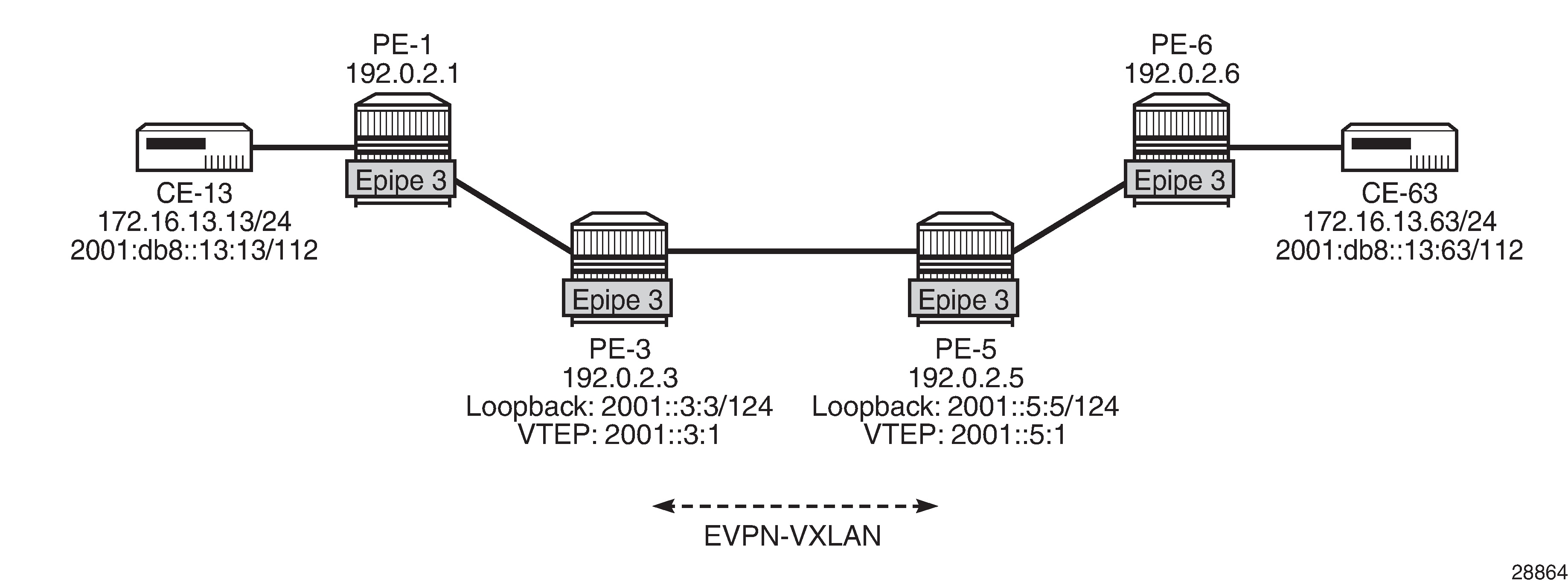
Configuration of Epipe 3
The following single-homed Epipe 3 using non-system IPv6 addresses for the VXLAN tunnel terminations is configured on PE-3.
# on PE-3:
configure
service
system
vxlan
tunnel-termination 10.0.3.1 fpe 1 create
tunnel-termination 2001::3:1 fpe 1 create
exit
exit
epipe 3 name "Epipe-3" customer 1 create
vxlan-src-vtep 2001::3:1
vxlan instance 1 vni 3 create
exit
bgp
exit
bgp-evpn
local-attachment-circuit AC-3_v6 create
eth-tag 163
exit
remote-attachment-circuit AC-5_v6 create
eth-tag 165
exit
evi 3
vxlan bgp 1 vxlan-instance 1
send-tunnel-encap # default
ecmp 2
no shutdown
exit
exit
sap 1/1/1:3 create
exit
no shutdown
exit
The service configuration on PE-5 is similar, as follows:
# on PE-5:
configure
service
system
vxlan
tunnel-termination 10.0.5.1 fpe 1 create
tunnel-termination 2001::5:1 fpe 1 create
exit
exit
epipe 3 name "Epipe-3" customer 1 create
vxlan-src-vtep 2001::5:1
vxlan instance 1 vni 3 create
exit
bgp
exit
bgp-evpn
local-attachment-circuit AC-5_v6 create
eth-tag 165
exit
remote-attachment-circuit AC-3_v6 create
eth-tag 163
exit
evi 3
vxlan bgp 1 vxlan-instance 1
send-tunnel-encap # default
ecmp 2
no shutdown
exit
exit
spoke-sdp 56:3 create
no shutdown
exit
no shutdown
exit
Verification
The connectivity between the CEs that are emulated by VPRN 13 is verified as follows:
*A:PE-1# ping router 13 172.16.13.63 rapid
PING 172.16.13.63 56 data bytes
!!!!!
---- 172.16.13.63 PING Statistics ----
5 packets transmitted, 5 packets received, 0.00% packet loss
round-trip min = 4.00ms, avg = 4.31ms, max = 4.86ms, stddev = 0.318ms
*A:PE-1# ping router 13 2001:db8::13:63 rapid
PING 2001:db8::13:63 56 data bytes
!!!!!
---- 2001:db8::13:63 PING Statistics ----
5 packets transmitted, 5 packets received, 0.00% packet loss
round-trip min = 4.13ms, avg = 4.36ms, max = 4.50ms, stddev = 0.130ms
On PE-3, the VXLAN destination for Epipe 3 is the non-system IPv6 address 2001::5:1 on PE-5, as follows:
*A:PE-3# show service id 3 vxlan destinations
===============================================================================
Egress VTEP, VNI
===============================================================================
VTEP Address Egress VNI Oper Vxlan
State Type
-------------------------------------------------------------------------------
2001::5:1 3 Up evpn
-------------------------------------------------------------------------------
Number of Egress VTEP, VNI : 1
-------------------------------------------------------------------------------
===============================================================================
===============================================================================
BGP EVPN VXLAN ES Dest
===============================================================================
I Eth Seg Id TEP Address VNI Last Changed
-------------------------------------------------------------------------------
No Matching Entries
===============================================================================
The following BGP-EVPN information for Epipe 3 on PE-3 includes the EVI and the AC names and Ethernet tags.
*A:PE-3# show service id 3 bgp-evpn
===============================================================================
BGP EVPN Table
===============================================================================
EVI : 3 Creation Origin : manual
Local AC Name : AC-3_v6
Eth Tag : 163
Endpoint : (Not Specified)
Ingress Label : 0
Remote AC Name : AC-5_v6
Eth Tag : 165
Endpoint : (Not Specified)
===============================================================================
BGP EVPN VXLAN Information
===============================================================================
Admin Status : Enabled Bgp Instance : 1
Vxlan Instance : 1
Max Ecmp Routes : 1
Default Route Tag : none
Send EVPN Encap : Enabled
===============================================================================
PE-3 received the following BGP-EVPN AD per-EVI route with RD 192.0.2.5:3 and next-hop 2001::5:1.
*A:PE-3# show router bgp routes evpn auto-disc rd 192.0.2.5:3
===============================================================================
BGP Router ID:192.0.2.3 AS:64500 Local AS:64500
===============================================================================
Legend -
Status codes : u - used, s - suppressed, h - history, d - decayed, * - valid
l - leaked, x - stale, > - best, b - backup, p - purge
Origin codes : i - IGP, e - EGP, ? - incomplete
===============================================================================
BGP EVPN Auto-Disc Routes
===============================================================================
Flag Route Dist. ESI NextHop
Tag Label
-------------------------------------------------------------------------------
u*>i 192.0.2.5:3 ESI-0 2001::5:1
165 VNI 3
-------------------------------------------------------------------------------
Routes : 1
===============================================================================
AA and SA multi-homed EVPN-VXLAN Epipe using system IPv4 addresses
EVPN-VXLAN Epipe 4 with AA MH and SA MH using system IPv4 addresses shows the example topology for EVPN-VXLAN Epipe 4 with AA MH ES "vES23_4" between PE-2 and PE-3 and SA MH ES "ES45" between PE-4 and PE-5.

Configuration of Epipe 4
On PE-1, Epipe 4 is configured as follows:
# on PE-1:
configure
service
epipe 4 name "Epipe-4" customer 1 create
sap 1/2/1:4 create
no shutdown
exit
sap lag-1:4 create
no shutdown
exit
no shutdown
exit
On PE-2 and PE-3, the AA MH ES "vES23_4" is configured as a virtual ES for LAG 1 and dot1q-tag 4, so it only affects Epipe 4.
# on PE-2:
configure
service
system
bgp-evpn
ethernet-segment "vES23_4" virtual create
esi 01:00:00:00:00:23:00:00:00:04
es-activation-timer 3
service-carving
mode auto
exit
multi-homing all-active
lag 1
dot1q
q-tag-range 4
exit
no shutdown
exit
exit
exit
On PE-2 and PE-3, Epipe 4 is configured as follows. The system IPv4 address is used as VXLAN termination, the local AC Ethernet tag is 123, and the remote AC Ethernet tag is 145.
# on PE-2:
configure
service
epipe 4 name "Epipe-4" customer 1 create
vxlan instance 1 vni 4 create
exit
bgp
exit
bgp-evpn
local-attachment-circuit AC-23 create
eth-tag 123
exit
remote-attachment-circuit AC-45 create
eth-tag 145
exit
evi 4
vxlan bgp 1 vxlan-instance 1
send-tunnel-encap # default
ecmp 2
no shutdown
exit
exit
sap lag-1:4 create
no shutdown
exit
no shutdown
exit
On PE-4 and PE-5, the SA MH ES "ES45" is configured with a GRE SDP toward PE-6: SDP 460 on PE-4 and SDP 560 on PE-6. The following is the configuration of "ES45" on PE-4:
# on PE-4:
configure
service
sdp 460 create
description "GRE SDP for SA MH"
far-end 192.0.2.6
keep-alive
shutdown
exit
no shutdown
exit
system
bgp-evpn
ethernet-segment "ES45" create
esi 01:00:00:00:00:45:00:00:00:04
service-carving
mode auto
exit
multi-homing single-active
sdp 460
no shutdown
exit
exit
exit
On PE-4, Epipe 4 is configured as follows. The configuration on PE-5 is similar, but with spoke-SDP 560:4 instead.
# on PE-4:
configure
service
epipe 4 name "Epipe-4" customer 1 create
vxlan instance 1 vni 4 create
exit
bgp
exit
bgp-evpn
local-attachment-circuit AC-45 create
eth-tag 145
exit
remote-attachment-circuit AC-23 create
eth-tag 123
exit
evi 4
vxlan bgp 1 vxlan-instance 1
send-tunnel-encap # default
ecmp 2
no shutdown
exit
exit
spoke-sdp 460:4 create
no shutdown
exit
no shutdown
exit
On PE-6, Epipe 4 is configured as follows:
# on PE-6:
configure
service
epipe 4 name "Epipe-4" customer 1 create
endpoint "EP" create
exit
sap 1/2/1:4 create
no shutdown
exit
spoke-sdp 640:4 endpoint "EP" create
no shutdown
exit
spoke-sdp 650:4 endpoint "EP" create
no shutdown
exit
no shutdown
exit
Verification
The connectivity between the CEs emulated by VPRN 14 can be verified as follows:
*A:PE-1# ping router 14 172.16.14.64 rapid
PING 172.16.14.64 56 data bytes
!!!!!
---- 172.16.14.64 PING Statistics ----
5 packets transmitted, 5 packets received, 0.00% packet loss
round-trip min = 3.84ms, avg = 5.12ms, max = 9.41ms, stddev = 2.15ms
*A:PE-1# ping router 14 2001:db8::14:64 rapid
PING 2001:db8::14:64 56 data bytes
!!!!!
---- 2001:db8::14:64 PING Statistics ----
5 packets transmitted, 5 packets received, 0.00% packet loss
round-trip min = 3.80ms, avg = 5.19ms, max = 9.89ms, stddev = 2.36ms
The following BGP-EVPN information for Epipe 4 includes the EVI and the AC names and Ethernet tags:
*A:PE-2# show service id 4 bgp-evpn
===============================================================================
BGP EVPN Table
===============================================================================
EVI : 4 Creation Origin : manual
Local AC Name : AC-23
Eth Tag : 123
Endpoint : (Not Specified)
Ingress Label : 0
Remote AC Name : AC-45
Eth Tag : 145
Endpoint : (Not Specified)
===============================================================================
BGP EVPN VXLAN Information
===============================================================================
Admin Status : Enabled Bgp Instance : 1
Vxlan Instance : 1
Max Ecmp Routes : 2
Default Route Tag : none
Send EVPN Encap : Enabled
===============================================================================
PE-4 received the following BGP-EVPN ES route with ESI 01:00:00:00:00:45:00:00:00:04 from PE-5:
*A:PE-4# show router bgp routes evpn eth-seg
===============================================================================
BGP Router ID:192.0.2.4 AS:64500 Local AS:64500
===============================================================================
Legend -
Status codes : u - used, s - suppressed, h - history, d - decayed, * - valid
l - leaked, x - stale, > - best, b - backup, p - purge
Origin codes : i - IGP, e - EGP, ? - incomplete
===============================================================================
BGP EVPN Eth-Seg Routes
===============================================================================
Flag Route Dist. ESI NextHop
OrigAddr
-------------------------------------------------------------------------------
u*>i 192.0.2.5:0 01:00:00:00:00:45:00:00:00:04 192.0.2.5
192.0.2.5
-------------------------------------------------------------------------------
Routes : 1
===============================================================================
Furthermore, PE-4 received the following AD per-EVI (with Ethernet tag 123 or 145) and AD per-ES (MAX-ET) routes for Epipe 4 from its three BGP peers. The ESI is non-zero for multi-homed services.
*A:PE-4# show router bgp routes evpn auto-disc
===============================================================================
BGP Router ID:192.0.2.4 AS:64500 Local AS:64500
===============================================================================
Legend -
Status codes : u - used, s - suppressed, h - history, d - decayed, * - valid
l - leaked, x - stale, > - best, b - backup, p - purge
Origin codes : i - IGP, e - EGP, ? - incomplete
===============================================================================
BGP EVPN Auto-Disc Routes
===============================================================================
Flag Route Dist. ESI NextHop
Tag Label
-------------------------------------------------------------------------------
---snip---
u*>i 192.0.2.2:4 01:00:00:00:00:23:00:00:00:04 192.0.2.2
123 VNI 4
u*>i 192.0.2.2:4 01:00:00:00:00:23:00:00:00:04 192.0.2.2
MAX-ET LABEL 0
u*>i 192.0.2.3:4 01:00:00:00:00:23:00:00:00:04 192.0.2.3
123 VNI 4
u*>i 192.0.2.3:4 01:00:00:00:00:23:00:00:00:04 192.0.2.3
MAX-ET LABEL 0
u*>i 192.0.2.5:4 01:00:00:00:00:45:00:00:00:04 192.0.2.5
145 VNI 4
u*>i 192.0.2.5:4 01:00:00:00:00:45:00:00:00:04 192.0.2.5
MAX-ET LABEL 0
-------------------------------------------------------------------------------
In AA MH ESs, the DF for VPLS services is the forwarder for Broadcast, Unknown unicast, and Multicast (BUM) traffic. In Epipes, however, all traffic is treated as unicast. The following tools commands on PE-2 and PE-3 show that DF is not applicable for AA MH ES "vES23_4.
*A:PE-2# tools dump service system bgp-evpn ethernet-segment "vES23_4" evi 4 df
[06/29/2021 09:59:05] All Active VPWS - DF N/A
*A:PE-3# tools dump service system bgp-evpn ethernet-segment "vES23_4" evi 4 df
[06/29/2021 09:59:03] All Active VPWS - DF N/A
The following command on PE-2 shows no DF candidates for ES "vES23_4", even though PE-2 (as well as PE-3) is considered as DF (DF=yes):
*A:PE-2# show service system bgp-evpn ethernet-segment name "vES23_4" evi 4
===============================================================================
EVI DF and Candidate List
===============================================================================
EVI SvcId Actv Timer Rem DF DF Last Change
-------------------------------------------------------------------------------
4 4 0 yes 06/29/2021 09:38:25
===============================================================================
===============================================================================
DF Candidates Time Added
-------------------------------------------------------------------------------
No entries found
===============================================================================
In the SA MH ES "ES45", PE-4 is DF out of a list of two candidates, as follows:
*A:PE-4# show service system bgp-evpn ethernet-segment name "ES45" evi 4
===============================================================================
EVI DF and Candidate List
===============================================================================
EVI SvcId Actv Timer Rem DF DF Last Change
-------------------------------------------------------------------------------
4 4 0 yes 06/29/2021 09:54:31
===============================================================================
===============================================================================
DF Candidates Time Added
-------------------------------------------------------------------------------
192.0.2.4 06/29/2021 09:54:44
192.0.2.5 06/29/2021 09:54:44
-------------------------------------------------------------------------------
Number of entries: 2
===============================================================================
On NDF PE-5, the spoke-SDP is operationally down with flag StandbyForMHProtocol, as follows:
*A:PE-5# show service id 4 sdp
===============================================================================
Services: Service Destination Points
===============================================================================
SdpId Type Far End addr Adm Opr I.Lbl E.Lbl
-------------------------------------------------------------------------------
560:4 Spok 192.0.2.6 Up Down 524282 524281
-------------------------------------------------------------------------------
Number of SDPs : 1
-------------------------------------------------------------------------------
===============================================================================
*A:PE-5# show service id 4 sdp detail | match "Flags"
Flags : StandbyForMHProtocol
The following command on PE-2 shows that the VXLAN destination for Epipe 4 is the ES "ES45" with ESI 01:00:00:00:00:45:00:00:00:04 and TEP address 192.0.2.4, which is the system IP address of the DF.
*A:PE-2# show service id 4 vxlan destinations
===============================================================================
Egress VTEP, VNI
===============================================================================
VTEP Address Egress VNI Oper Vxlan
State Type
-------------------------------------------------------------------------------
No Matching Entries
===============================================================================
===============================================================================
BGP EVPN VXLAN ES Dest
===============================================================================
I Eth Seg Id TEP Address VNI Last Changed
-------------------------------------------------------------------------------
1 01:00:00:00:00:45:00:00:00:04 192.0.2.4 4 06/29/2021 09:54:47
-------------------------------------------------------------------------------
===============================================================================
On PE-2, the following command shows that BGP-EVPN AD per-EVI routes with Ethernet tag 145 from PE-4 (RD 192.0.2.4:4) are sent with primary flag P=1 and AD per-EVI routes with Ethernet tag 145 from PE-5 (RD 192.0.2.5:4) are sent with primary flag P=0 and backup flag B=1.
*A:PE-3# show router bgp routes evpn auto-disc tag 145 detail
| match expression "C:|Route Dist"
Community : target:64500:4 l2-attribute:MTU: 1514 C: 0 P: 1 B: 0
Route Dist. : 192.0.2.4:4
---snip---
Community : target:64500:4 l2-attribute:MTU: 1514 C: 0 P: 0 B: 1
Route Dist. : 192.0.2.5:4
---snip---
AA and SA multi-homed EVPN-VXLAN Epipe using non-system IPv4 addresses
EVPN-VXLAN Epipe 5 with AA MH and SA MH using non-system IPv4 addresses shows the example topology for EVPN-VXLAN Epipe 5 with AA MH ES "vES23_5" between PE-2 and PE-3 and SA MH ES "ES45_5" between PE-4 and PE-5.
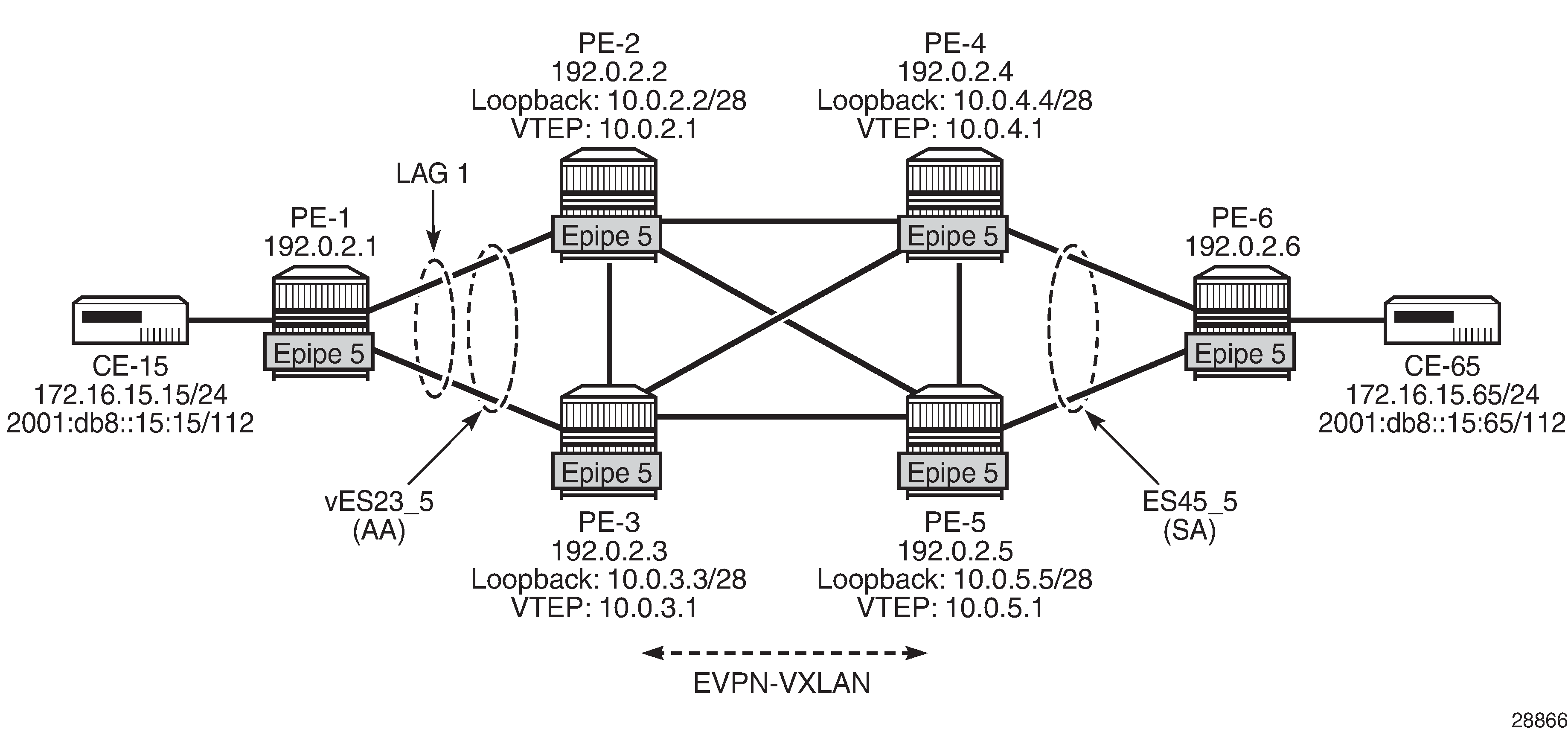
The configuration of Epipe 5 on PE-1 is similar to the configuration of Epipe 4 on PE-1, so it is not shown here. The same applies for Epipe 5 on PE-6.
On PE-2, VTEP 10.0.2.1 is used instead of the system IP address. The ES must include two additional parameters for the DF selection: es-orig-ip and route-next-hop, which are both equal to the VTEP. Without these parameters, the DF selection will not work. The es-orig-ip command modifies the originator IP address of the ES route and the route-next-hop modifies the next-hop of the AD per-ES routes for the ES. The service configuration on PE-2 is as follows:
# on PE-2:
configure
service
system
vxlan
tunnel-termination 10.0.2.1 fpe 1 create
tunnel-termination 2001::2:1 fpe 1 create
exit
bgp-evpn
ethernet-segment "vES23_5" virtual create
esi 01:00:00:00:00:23:00:00:00:05
es-orig-ip 10.0.2.1
route-next-hop 10.0.2.1
service-carving
mode auto
exit
multi-homing all-active
lag 1
dot1q
q-tag-range 5
exit
no shutdown
exit
exit
exit
epipe 5 name "Epipe-5" customer 1 create
vxlan-src-vtep 10.0.2.1
vxlan instance 1 vni 5 create
exit
bgp
exit
bgp-evpn
local-attachment-circuit AC-23_2 create
eth-tag 223
exit
remote-attachment-circuit AC-45_2 create
eth-tag 245
exit
evi 5
vxlan bgp 1 vxlan-instance 1
ecmp 2
no shutdown
exit
exit
sap lag-1:5 create
no shutdown
exit
no shutdown
exit
The service configuration on PE-3 is similar.
On PE-4, the service configuration is as follows:
# on PE-4:
configure
service
sdp 465 create
far-end 192.0.2.6
keep-alive
shutdown
exit
no shutdown
exit
system
vxlan
tunnel-termination 10.0.4.1 fpe 1 create
exit
bgp-evpn
ethernet-segment "ES45_5" create
esi 01:00:00:00:00:45:00:00:00:05
es-orig-ip 10.0.4.1
route-next-hop 10.0.4.1
service-carving
mode auto
exit
multi-homing single-active
sdp 465
no shutdown
exit
exit
exit
epipe 5 name "Epipe-5" customer 1 create
vxlan-src-vtep 10.0.4.1
vxlan instance 1 vni 5 create
exit
bgp
exit
bgp-evpn
local-attachment-circuit AC-45_2 create
eth-tag 245
exit
remote-attachment-circuit AC-23_2 create
eth-tag 223
exit
evi 5
vxlan bgp 1 vxlan-instance 1
ecmp 2
no shutdown
exit
exit
spoke-sdp 465:5 create
no shutdown
exit
no shutdown
exit
In the AA MH ES, both PE-2 and PE-3 are DF. PE-4 receives BGP-EVPN autodiscovery routes with Ethernet tag 223 from PE-2 and PE-3 with the primary flag set to 1, as follows:
*A:PE-4# show router bgp routes evpn auto-disc tag 223 detail
| match expression "C:|Route Dist"
Community : target:64500:5 l2-attribute:MTU: 1514 C: 0 P: 1 B: 0
Route Dist. : 192.0.2.2:5
Community : target:64500:5 l2-attribute:MTU: 1514 C: 0 P: 1 B: 0
Route Dist. : 192.0.2.2:5
Community : target:64500:5 l2-attribute:MTU: 1514 C: 0 P: 1 B: 0
Route Dist. : 192.0.2.3:5
Community : target:64500:5 l2-attribute:MTU: 1514 C: 0 P: 1 B: 0
Route Dist. : 192.0.2.3:5
The VXLAN destinations for Epipe 5 on PE-4 are the non-system TEP addresses 10.0.2.1 and 10.0.3.1 in ES "vES23_5" with ESI 01:00:00:00:00:23:00:00:00:05, as follows:
*A:PE-4# show service id 5 vxlan destinations
===============================================================================
Egress VTEP, VNI
===============================================================================
VTEP Address Egress VNI Oper Vxlan
State Type
-------------------------------------------------------------------------------
No Matching Entries
===============================================================================
===============================================================================
BGP EVPN VXLAN ES Dest
===============================================================================
I Eth Seg Id TEP Address VNI Last Changed
-------------------------------------------------------------------------------
1 01:00:00:00:00:23:00:00:00:05 10.0.2.1 5 06/29/2021 10:06:33
1 01:00:00:00:00:23:00:00:00:05 10.0.3.1 5 06/29/2021 10:06:33
-------------------------------------------------------------------------------
===============================================================================
In the SA MH ES, PE-5 is DF and PE-4 is NDF. PE-2 receives BGP-EVPN autodiscovery routes with Ethernet tag 245 from PE-4 with backup flag 1 and from PE-5 with primary flag 1, as follows:
*A:PE-2# show router bgp routes evpn auto-disc tag 245 detail
| match expression "C:|Route Dist"
Community : target:64500:5 l2-attribute:MTU: 1514 C: 0 P: 0 B: 1
Route Dist. : 192.0.2.4:5
Community : target:64500:5 l2-attribute:MTU: 1514 C: 0 P: 0 B: 1
Route Dist. : 192.0.2.4:5
Community : target:64500:5 l2-attribute:MTU: 1514 C: 0 P: 1 B: 0
Route Dist. : 192.0.2.5:5
Community : target:64500:5 l2-attribute:MTU: 1514 C: 0 P: 1 B: 0
Route Dist. : 192.0.2.5:5
The VXLAN destination for Epipe 5 on PE-2 is the non-system TEP address 10.0.5.1 of DF PE-5 in ES "ES45_5" with ESI 01:00:00:00:00:45:00:00:00:05, as follows:
*A:PE-2# show service id 5 vxlan destinations
===============================================================================
Egress VTEP, VNI
===============================================================================
VTEP Address Egress VNI Oper Vxlan
State Type
-------------------------------------------------------------------------------
No Matching Entries
===============================================================================
===============================================================================
BGP EVPN VXLAN ES Dest
===============================================================================
I Eth Seg Id TEP Address VNI Last Changed
-------------------------------------------------------------------------------
1 01:00:00:00:00:45:00:00:00:05 10.0.5.1 5 06/29/2021 10:07:30
-------------------------------------------------------------------------------
===============================================================================
AA and SA multi-homed EVPN-VXLAN Epipe using non-system IPv6 addresses
EVPN-VXLAN Epipe 6 with AA MH and SA MH using non-system IPv6 addresses shows the example topology for EVPN-VXLAN Epipe 6 with AA MH ES "vES23_6" between PE-2 and PE-3 and SA MH ES "ES45_6" between PE-4 and PE-5.

The service configuration on PE-2 is as follows:
# on PE-2:
configure
service
system
vxlan
tunnel-termination 2001::2:1 fpe 1 create
exit
bgp-evpn
ethernet-segment "vES23_6" virtual create
esi 01:00:00:00:00:23:00:00:00:06
es-orig-ip 2001::2:1
route-next-hop 2001::2:1
service-carving
mode auto
exit
multi-homing all-active
lag 1
dot1q
q-tag-range 6
exit
no shutdown
exit
exit
exit
epipe 6 name "Epipe-6" customer 1 create
vxlan-src-vtep 2001::2:1
vxlan instance 1 vni 6 create
exit
bgp
exit
bgp-evpn
local-attachment-circuit AC-23_v6 create
eth-tag 623
exit
remote-attachment-circuit AC-45_v6 create
eth-tag 645
exit
evi 6
vxlan bgp 1 vxlan-instance 1
send-tunnel-encap # default
ecmp 2
no shutdown
exit
exit
sap lag-1:6 create
no shutdown
exit
no shutdown
exit
The service configuration on PE-4 is as follows:
# on PE-4:
configure
service
sdp 466 create
far-end 192.0.2.6
keep-alive
shutdown
exit
no shutdown
exit
system
vxlan
tunnel-termination 10.0.4.1 fpe 1 create
tunnel-termination 2001::4:1 fpe 1 create
exit
bgp-evpn
ethernet-segment "ES45_6" create
esi 01:00:00:00:00:45:00:00:00:06
es-orig-ip 2001::4:1
route-next-hop 2001::4:1
service-carving
mode auto
exit
multi-homing single-active
sdp 466
no shutdown
exit
exit
exit
epipe 6 name "Epipe-6" customer 1 create
vxlan-src-vtep 2001::4:1
vxlan instance 1 vni 6 create
exit
bgp
exit
bgp-evpn
local-attachment-circuit AC-45_v6 create
eth-tag 645
exit
remote-attachment-circuit AC-23_v6 create
eth-tag 623
exit
evi 6
vxlan bgp 1 vxlan-instance 1
send-tunnel-encap # default
ecmp 2
no shutdown
exit
exit
spoke-sdp 466:6 create
no shutdown
exit
no shutdown
exit
Conclusion
EVPN-VXLAN VPWS is similar to EVPN-MPLS VPWS, and can be used in networks without MPLS.